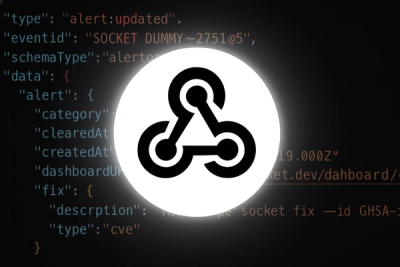
Product
Introducing Webhook Events for Alert Changes
Add real-time Socket webhook events to your workflows to automatically receive software supply chain alert changes in real time.
@aws-sdk/client-location
Advanced tools
AWS SDK for JavaScript Location Client for Node.js, Browser and React Native
AWS SDK for JavaScript Location Client for Node.js, Browser and React Native.
"Suite of geospatial services including Maps, Places, Routes, Tracking, and Geofencing"
To install this package, simply type add or install @aws-sdk/client-location using your favorite package manager:
npm install @aws-sdk/client-locationyarn add @aws-sdk/client-locationpnpm add @aws-sdk/client-locationThe AWS SDK is modulized by clients and commands.
To send a request, you only need to import the LocationClient and
the commands you need, for example ListKeysCommand:
// ES5 example
const { LocationClient, ListKeysCommand } = require("@aws-sdk/client-location");
// ES6+ example
import { LocationClient, ListKeysCommand } from "@aws-sdk/client-location";
To send a request, you:
send operation on client with command object as input.destroy() to close open connections.// a client can be shared by different commands.
const client = new LocationClient({ region: "REGION" });
const params = {
/** input parameters */
};
const command = new ListKeysCommand(params);
We recommend using await operator to wait for the promise returned by send operation as follows:
// async/await.
try {
const data = await client.send(command);
// process data.
} catch (error) {
// error handling.
} finally {
// finally.
}
Async-await is clean, concise, intuitive, easy to debug and has better error handling as compared to using Promise chains or callbacks.
You can also use Promise chaining to execute send operation.
client.send(command).then(
(data) => {
// process data.
},
(error) => {
// error handling.
}
);
Promises can also be called using .catch() and .finally() as follows:
client
.send(command)
.then((data) => {
// process data.
})
.catch((error) => {
// error handling.
})
.finally(() => {
// finally.
});
We do not recommend using callbacks because of callback hell, but they are supported by the send operation.
// callbacks.
client.send(command, (err, data) => {
// process err and data.
});
The client can also send requests using v2 compatible style. However, it results in a bigger bundle size and may be dropped in next major version. More details in the blog post on modular packages in AWS SDK for JavaScript
import * as AWS from "@aws-sdk/client-location";
const client = new AWS.Location({ region: "REGION" });
// async/await.
try {
const data = await client.listKeys(params);
// process data.
} catch (error) {
// error handling.
}
// Promises.
client
.listKeys(params)
.then((data) => {
// process data.
})
.catch((error) => {
// error handling.
});
// callbacks.
client.listKeys(params, (err, data) => {
// process err and data.
});
When the service returns an exception, the error will include the exception information, as well as response metadata (e.g. request id).
try {
const data = await client.send(command);
// process data.
} catch (error) {
const { requestId, cfId, extendedRequestId } = error.$metadata;
console.log({ requestId, cfId, extendedRequestId });
/**
* The keys within exceptions are also parsed.
* You can access them by specifying exception names:
* if (error.name === 'SomeServiceException') {
* const value = error.specialKeyInException;
* }
*/
}
Please use these community resources for getting help. We use the GitHub issues for tracking bugs and feature requests, but have limited bandwidth to address them.
aws-sdk-js
on AWS Developer Blog.aws-sdk-js.To test your universal JavaScript code in Node.js, browser and react-native environments, visit our code samples repo.
This client code is generated automatically. Any modifications will be overwritten the next time the @aws-sdk/client-location package is updated.
To contribute to client you can check our generate clients scripts.
This SDK is distributed under the Apache License, Version 2.0, see LICENSE for more information.
Mapbox is a popular location-based service that provides APIs for maps, geocoding, and routing. It offers a wide range of features and is known for its high-quality maps and ease of use. Compared to @aws-sdk/client-location, Mapbox provides more customization options for maps and a broader set of tools for developers.
HERE is a location-based service that offers APIs for maps, geocoding, routing, and more. It is known for its accurate and reliable data. Compared to @aws-sdk/client-location, HERE provides more detailed traffic and transit information and is often used in automotive and logistics industries.
FAQs
AWS SDK for JavaScript Location Client for Node.js, Browser and React Native
The npm package @aws-sdk/client-location receives a total of 402,149 weekly downloads. As such, @aws-sdk/client-location popularity was classified as popular.
We found that @aws-sdk/client-location demonstrated a healthy version release cadence and project activity because the last version was released less than a year ago. It has 2 open source maintainers collaborating on the project.
Did you know?

Socket for GitHub automatically highlights issues in each pull request and monitors the health of all your open source dependencies. Discover the contents of your packages and block harmful activity before you install or update your dependencies.

Product
Add real-time Socket webhook events to your workflows to automatically receive software supply chain alert changes in real time.

Security News
ENISA has become a CVE Program Root, giving the EU a central authority for coordinating vulnerability reporting, disclosure, and cross-border response.

Product
Socket now scans OpenVSX extensions, giving teams early detection of risky behaviors, hidden capabilities, and supply chain threats in developer tools.